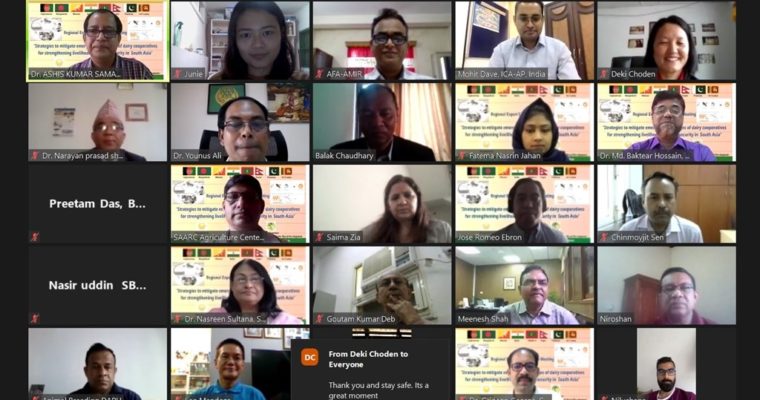The SAARC Agriculture Centre (SAC) in technical partnership with Asian Farmers’ Association for Sustainable Rural Development (AFA) conducted a virtual regional expert consultation meeting on “Strategies to mitigate emerging challenges of dairy cooperatives for strengthening livelihood and food security in South Asia”. Seventeen representatives of SAARC Member States including technical experts from SAC as well as around 15 representatives from farmers’ organizations and guests participated in the two-day event held on 12-13 April 2021. The consultation meeting aimed to present an introspection of the existing dairy cooperative policies among the Member States and modifications soughed to make it farmer’s centric; understand and analyze current challenges of dairy cooperatives in the SAARC region and identify policies requirement for enhancing the trade across the SAARC Member States for the milk and milk products generated from dairy cooperatives.
In her remarks, Esther Penunia, Secretary-General of AFA, emphasized the important role that cooperatives play in mitigating barriers to the development of the dairy industry in the SAARC region by focusing and strengthening their involvement in the entire value chain. “Farmers’ cooperatives can be the aggregator on processing, marketing, and the final stage of distribution”, Penunia added.
The meeting’s chief guest, Md. Shamsul Haque, Additional Foreign Secretary (SAARC and BIMSTEC), Ministry of Foreign Affairs, Bangladesh stated that the dairy cooperatives play a pivotal part in striking a balance between ensuring adequate farmers’ income and affordability to consumers. He further underscored the need to consider ground-level situations in developing policies for the industry.
All SAARC member states except the Maldives presented country papers. The representatives shared information on their respective dairy cooperative models including the challenges they are confronted with and ways forward. India discussed its Dairy Development Programs that led the county to be a dairy exporter from a situation of import dependency. “Development programs helped us to shift from being dependent in importation to exportation” as stated by Chinmoyjit Sen of India.
Financial issues, lack of loyalty among members, and rivalries among farmer members are the main problems facing the dairy cooperatives of Afghanistan. Notwithstanding this, Khaliq Mahjoob of Afghanistan highlighted the contributions of dairy cooperatives to rural development. “Dairy cooperatives have the potential to benefit the farmers through supplying inputs and marketing of farm products that could contribute to a reduction in rural poverty”, he said. This was echoed by Dr. Chaudhary of Nepal in his presentation where he mentioned that the dairy subsector is instrumental in reducing poverty through employment and income generation.
Other dairy cooperative challenges cited in the presentations are high production cost, low productivity, unstable prices, lack of cold chain facilities, improper animal health care, unsatisfactory law and order situation, high degree of government control, and weak value chain actors.
On the second day, dairy farmers from Bhutan and Bangladesh were also asked to present actual ground-level challenges confronting them. According to the Nasir Uddin of KKM Bangladesh Bangladesh, low productivity and high production cost are the major problems they currently facing confirming the challenges mentioned during the first day. On the other hand, Chencho Wangdi, a young farmer from Bhutan, mentioned that adaptability of the foreign breeds and marketing as some of their major concerns. Speaking for the dairy farmers of Pakistan, Saima Zia of Crofter Foundation said that lack of capital is one of the main problems of dairy farmers in the country. “Financing is difficult since most farmers do not own land”, she added.
The guest speaker from AFA, Jojo Ebron, explained the framework strategy of AFA in building agricultural cooperatives and the key trends in the dairy industry in Asia.
The meeting concluded with the formulation of 11 main recommendations from the participants. Most notable among the recommendations generated are intra-regional cooperation in the form of exchange of high-yielding germplasm of indigenous dairy animals; exchange of professionals/experts to assist in easing out work permits and sharing of dairy program experiences.
In terms of the value chain, part of the recommendations is to strengthen input services to the primary members of dairy cooperatives including high-yielding dairy animals, quality feeds and fodder seed, mineral mixture, silage, artificial insemination, deworming, vaccination, etc. Click this link to view the 11 recommendations.




Comments are closed